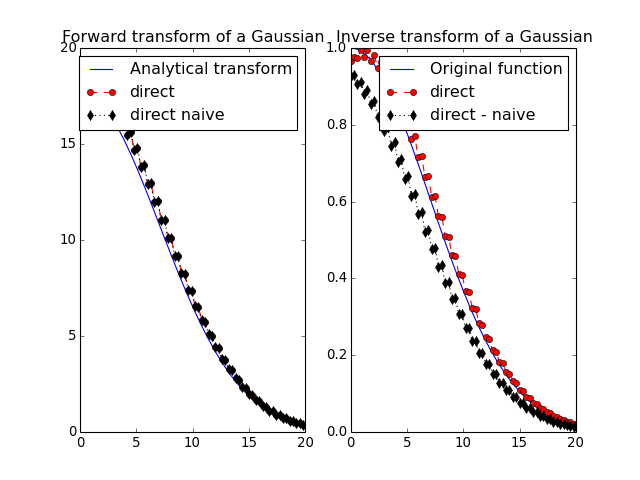Example: Direct Gaussian¶
#!/usr/bin/env python
# -*- coding: utf-8 -*-
from __future__ import absolute_import
from __future__ import division
from __future__ import print_function
from __future__ import unicode_literals
import matplotlib.pyplot as plt
from time import time
import sys
from abel.direct import direct_transform
from abel.tools.analytical import GaussianAnalytical
n = 101
r_max = 30
sigma = 10
ref = GaussianAnalytical(n, r_max, sigma, symmetric=False)
fig, ax = plt.subplots(1,2)
ax[0].set_title('Forward transform of a Gaussian')
ax[1].set_title('Inverse transform of a Gaussian')
ax[0].plot(ref.r, ref.abel, 'b', label='Analytical transform')
recon = direct_transform(ref.func, dr=ref.dr, direction="forward",
correction=True, backend='C')
ax[0].plot(ref.r, recon , '--o',c='red', label='direct')
recon = direct_transform(ref.func, dr=ref.dr, direction="forward",
correction=True, backend='Python')
ax[0].plot(ref.r, recon , ':d', c='k', label='direct naive')
ax[1].plot(ref.r, ref.func, 'b', label='Original function')
recon = direct_transform(ref.abel, dr=ref.dr, direction="inverse",
correction=True)
ax[1].plot(ref.r, recon , '--o', c='red', label='direct')
recon = direct_transform(ref.abel, dr=ref.dr, direction="inverse",
correction=False)
ax[1].plot(ref.r, recon , ':d', c='k', label='direct - naive')
for axi in ax:
axi.set_xlim(0, 20)
axi.legend()
plt.show()
(Source code, png, hires.png, pdf)
